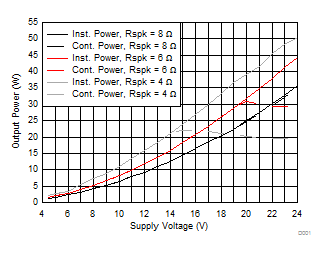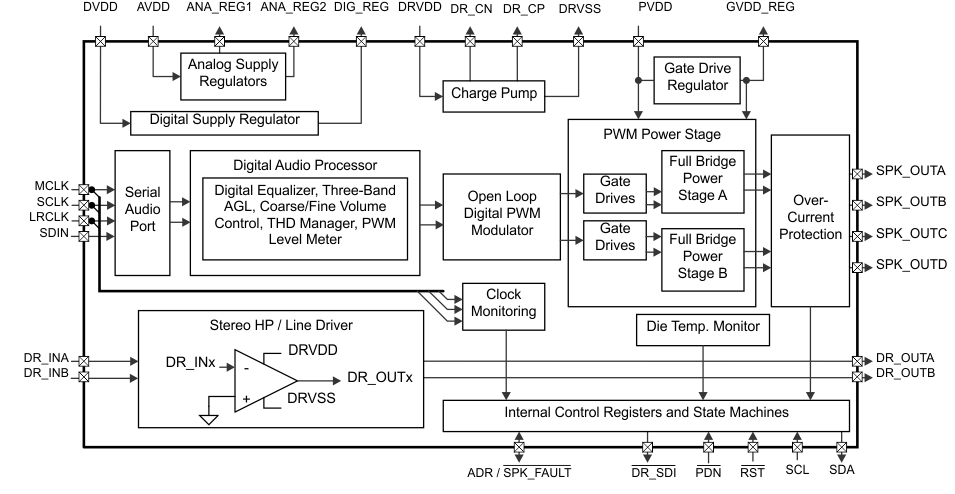SLASEA5C March 2016 – May 2017 TAS5753MD
PRODUCTION DATA.
- 1 Features
- 2 Applications
- 3 Description
- 4 Revision History
- 5 Pin Configuration and Functions
-
6 Specifications
- 6.1 Absolute Maximum Ratings
- 6.2 ESD Ratings
- 6.3 Recommended Operating Conditions
- 6.4 Thermal Characteristics
- 6.5 Electrical Characteristics
- 6.6 Speaker Amplifier Characteristics in All Modes
- 6.7 Speaker Amplifier Characteristics in Stereo Bridge Tied Load (BTL) Mode
- 6.8 Speaker Amplifier Characteristics in Stereo Post-Filter Parallel Bridge Tied Load (Post-Filter PBTL) Mode
- 6.9 Headphone Amplifier and Line Driver Characteristics
- 6.10 Protection Circuitry Characteristics
- 6.11 I²C Interface Timing Requirements
- 6.12 Serial Audio Port Timing Requirements
- 6.13 Typical Electrical Power Consumption
- 6.14 Typical Characteristics
-
7 Detailed Description
- 7.1 Overview
- 7.2 Functional Block Diagram
- 7.3 Audio Signal Processing Overview
- 7.4 Feature Description
- 7.5 Device Functional Modes
- 7.6 Programming
- 7.7
Register Maps
- 7.7.1 Register Summary
- 7.7.2
Detailed Register Descriptions
- 7.7.2.1 Clock Control Register (0x00)
- 7.7.2.2 Device ID Register (0x01)
- 7.7.2.3 Error Status Register (0x02)
- 7.7.2.4 System Control Register 1 (0x03)
- 7.7.2.5 Serial Data Interface Register (0x04)
- 7.7.2.6 System Control Register 2 (0x05)
- 7.7.2.7 Soft Mute Register (0x06)
- 7.7.2.8 Volume Registers (0x07, 0x08, 0x09)
- 7.7.2.9 Volume Configuration Register (0x0E)
- 7.7.2.10 Modulation Limit Register (0x10)
- 7.7.2.11 Interchannel Delay Registers (0x11, 0x12, 0x13, and 0x14)
- 7.7.2.12 PWM Shutdown Group Register (0x19)
- 7.7.2.13 Start/Stop Period Register (0x1A)
- 7.7.2.14 Oscillator Trim Register (0x1B)
- 7.7.2.15 BKND_ERR Register (0x1C)
- 7.7.2.16 Input Multiplexer Register (0x20)
- 7.7.2.17 PWM Output MUX Register (0x25)
- 7.7.2.18 AGL Control Register (0x46)
- 7.7.2.19 PWM Switching Rate Control Register (0x4F)
- 7.7.2.20 Bank Switch and EQ Control (0x50)
-
8 Application and Implementation
- 8.1 Application Information
- 8.2
Typical Applications
- 8.2.1
Stereo Bridge Tied Load Application
- 8.2.1.1 Design Requirements
- 8.2.1.2 Detailed Design Procedure
- 8.2.1.3 Application Performance Plots
- 8.2.2 Mono Parallel Bridge Tied Load Application
- 8.2.3 Stereo BTL Configuration with Headphone and Line Driver Amplifier Application
- 8.2.4 Mono Parallel Bridge-Tied Load Configuration with Headphone and Line Driver Amplifier
- 8.2.1
Stereo Bridge Tied Load Application
- 9 Power Supply Recommendations
- 10Layout
- 11Device and Documentation Support
パッケージ・オプション
メカニカル・データ(パッケージ|ピン)
- DCA|48
サーマルパッド・メカニカル・データ
- DCA|48
発注情報
1 Features
- Audio Input/Output
- Supports BTL Configuration With 4-Ω Load
- One Stereo Serial Audio Input
- I2C Address Selection Pin
- Supports 44.1-kHz and 48-kHz Sample Rates (LJ/RJ/I2S)
- Headphone Amplifier and Line Driver
- Independent Channel Volume Controls With Gain of 24 dB to Mute in 0.125-dB Steps
- Programmable Three-Band Automatic Gain Limiting (AGL)
- 20 Programmable Biquads for Speaker EQ and Other Audio-Processing Features
- General Features
- I2C Serial Control Interface Operational Without MCLK
- Automatic Rate Detection
- Thermal, Short-Circuit, and Undervoltage Protection
- 105-dB SNR, A-Weighted, Referenced to Full Scale (0 dB)
- Up to 90% Efficient
- AD, BD, and Ternary Modulation
- PWM Level Meter
- Operates from 4.5-V to 24-V PVDD
2 Applications
- LCD TV, LED TV
- Low-Cost Soundbar
- General Low-Cost Audio Equipment
3 Description
The TAS5753MD device is an efficient, digital-input audio amplifier for driving stereo speakers configured as a bridge tied load (BTL). One serial data input allows processing of up to two discrete audio channels and seamless integration to most digital audio processors and MPEG decoders. The device accepts a wide range of input data and data rates. A fully programmable data path routes these channels to the internal speaker drivers.
The TAS5753MD device is a slave-only device receiving all clocks from external sources. The TAS5753MD device operates with a PWM carrier between a 384-kHz switching rate and a 288-kHz switching rate, depending on the input sample rate. Oversampling combined with a fourth-order noise shaper provides a flat noise floor and excellent dynamic range from 20 Hz to 20 kHz. The device has an integrated Directpath™ Headphone amplifier and linedriver to increase the system-level integration and reduce total solution costs.
Device Information(1)
| PART NUMBER | PACKAGE | BODY SIZE (NOM) |
|---|---|---|
| TAS5753MD | HTSSOP (48) | 12.50 mm × 6.10 mm |
- For all available packages, see the orderable addendum at the end of the data sheet.
Output Power vs Supply Voltage

Functional Block Diagram
